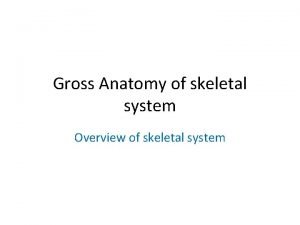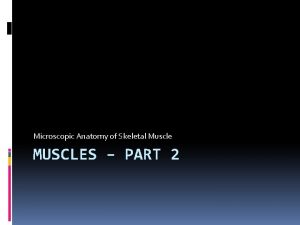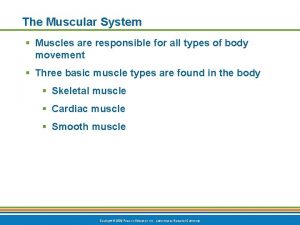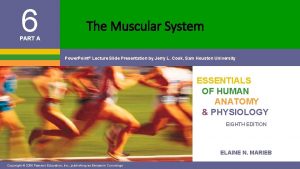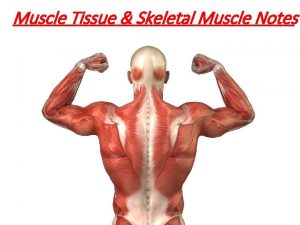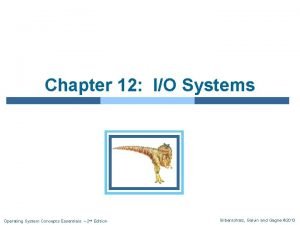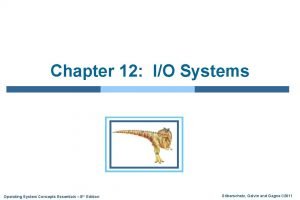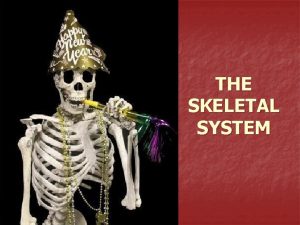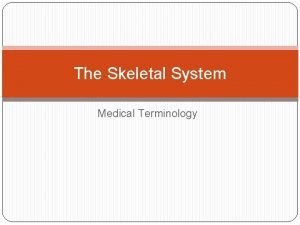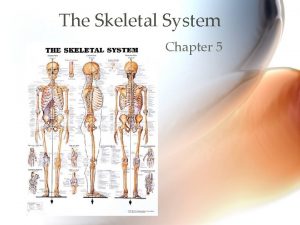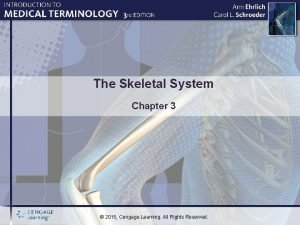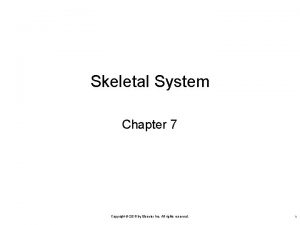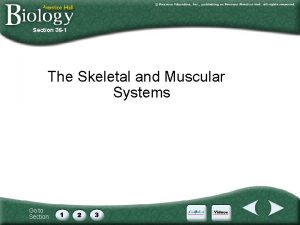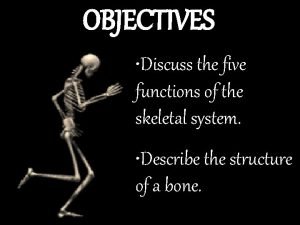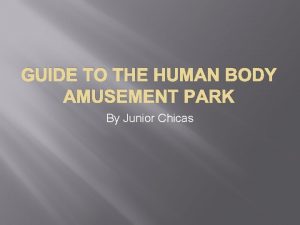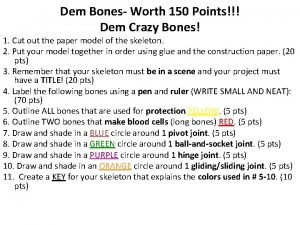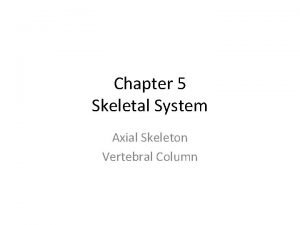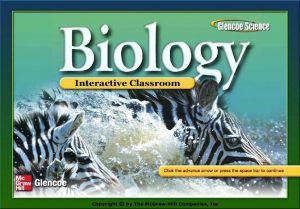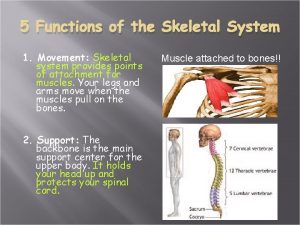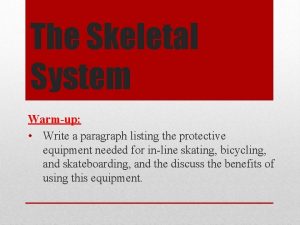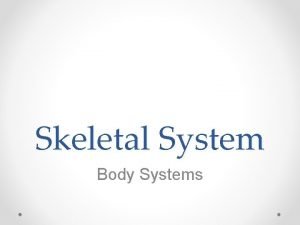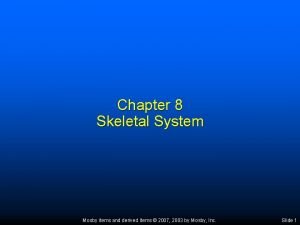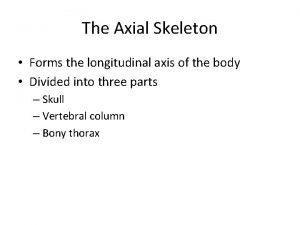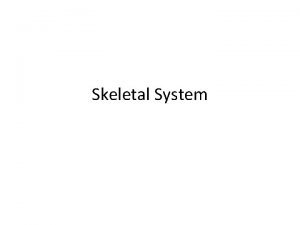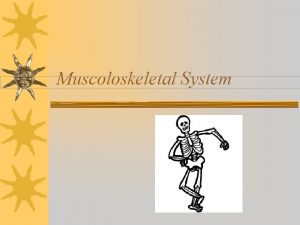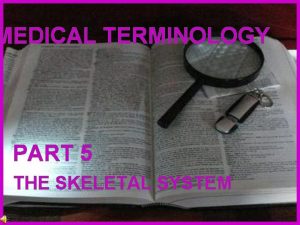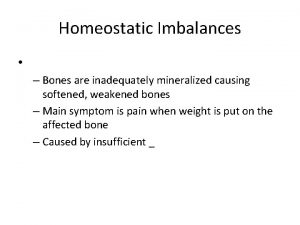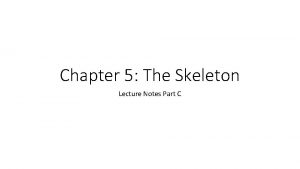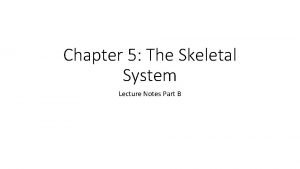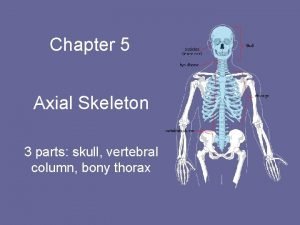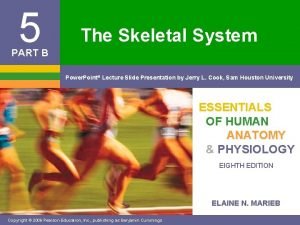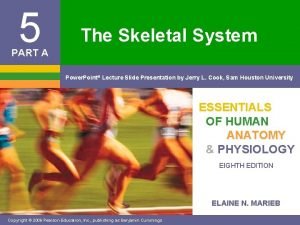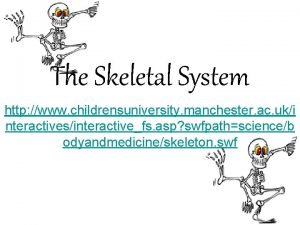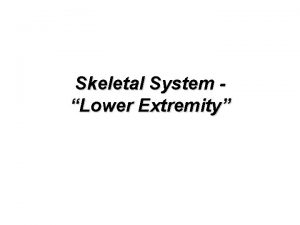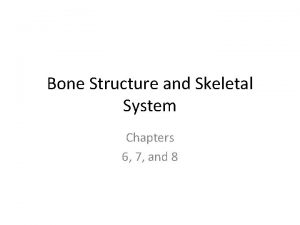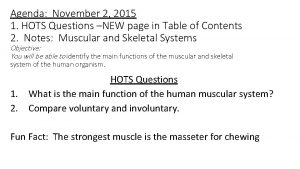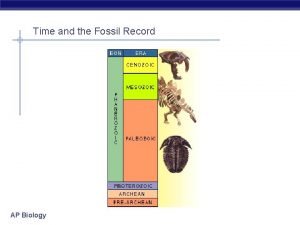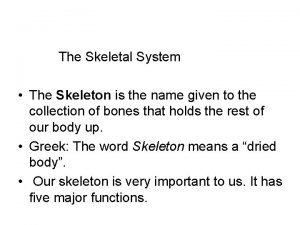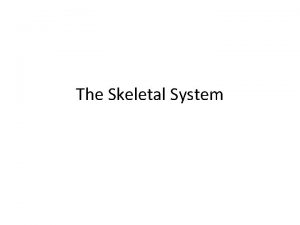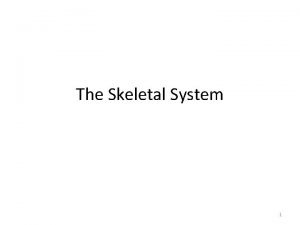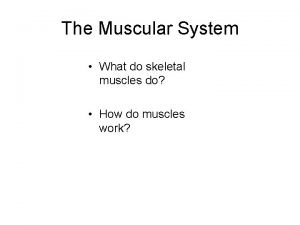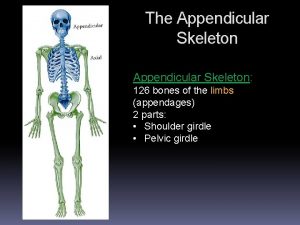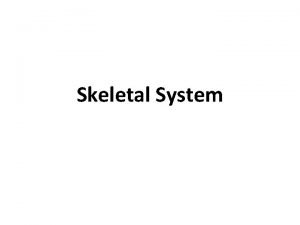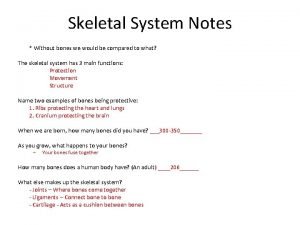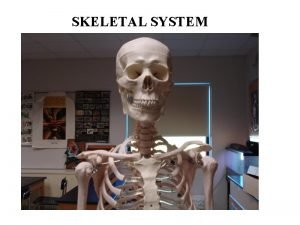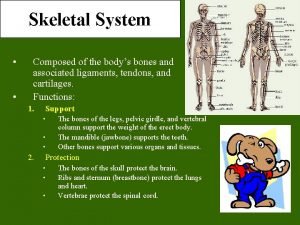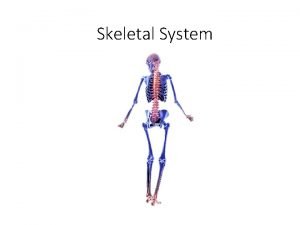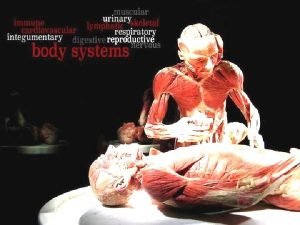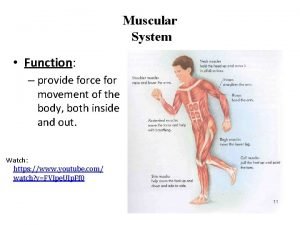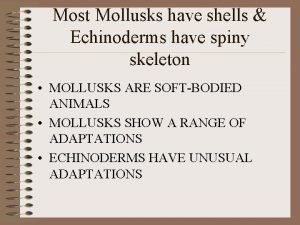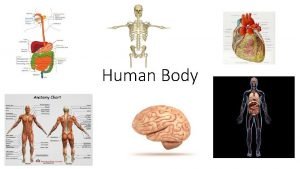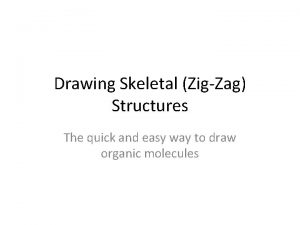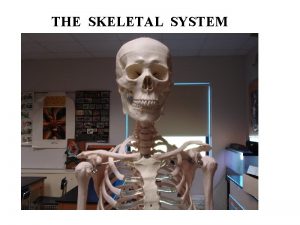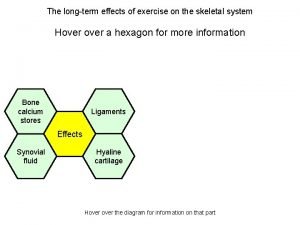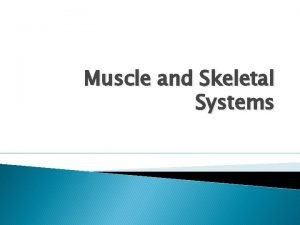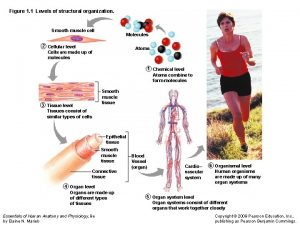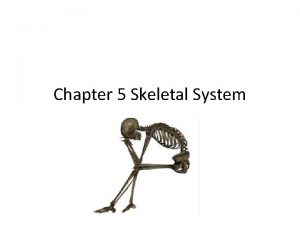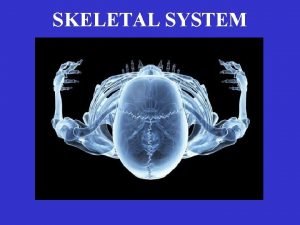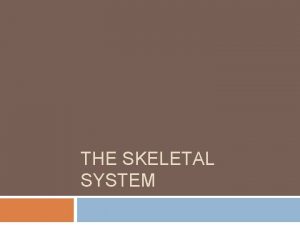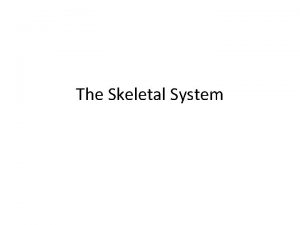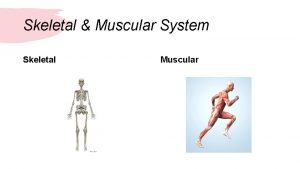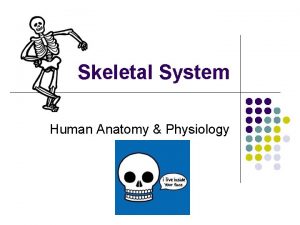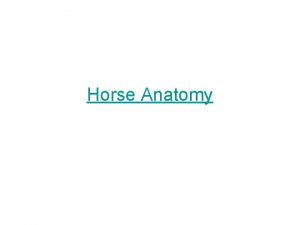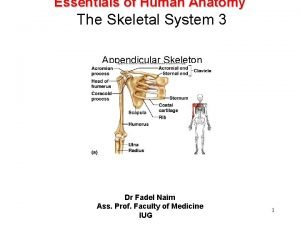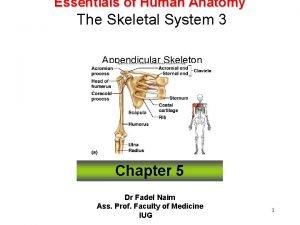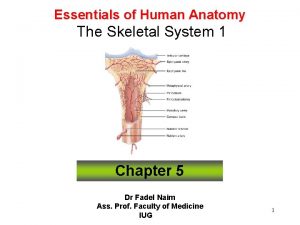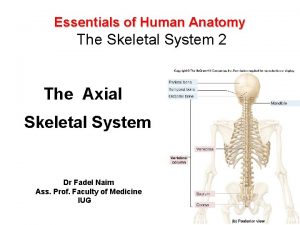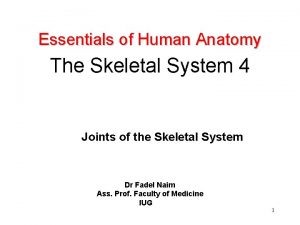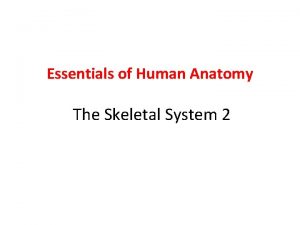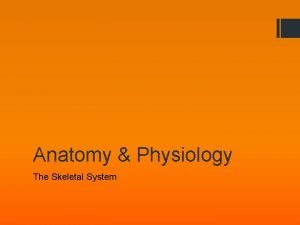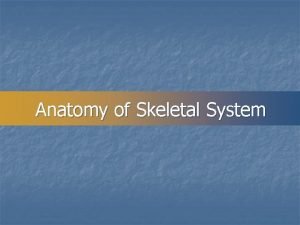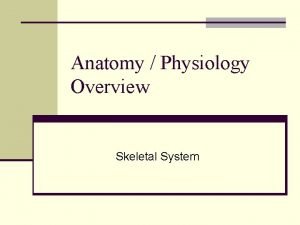Essentials of Human Anatomy The Skeletal System 1















































































- Slides: 79

Essentials of Human Anatomy The Skeletal System 1

Bone • Bones are organs • Bones are composed of all tissue types. • Their primary component is osseous connective tissue. • The matrix is sturdy and rigid due to calcification (also called mineralization).

Function of Bones • Support: form the framework that supports the body and cradles soft organs • Protection: provide a protective case for the brain, spinal cord, and vital organs • Movement: provide levers for muscles • Mineral storage: reservoir for minerals, especially calcium and phosphorus • Blood cell formation: hematopoiesis occurs within the marrow cavities of bones • Energy storage (fat in yellow marrow)

Support and Protection • Bones provide structural support and serve as a framework for the entire body. • Bones protect many delicate tissues and organs from injury and trauma.

Movement • Muscles attach to the bones of the skeleton – Contract and pull on bone – Functions as a series of levers.

Storage of Mineral and Energy Reserves • More than 90% of the body’s reserves of the minerals calcium and phosphate are stored and released by bone.

Hematopoiesis Blood Cell Formation • Blood cell production in red bone marrow – located in some spongy bone. • Red bone marrow contains stem cells – form all of the blood cell types.

Changes in the Human Skeleton • In embryos, the skeleton is primarily hyaline cartilage • During development, much of this cartilage is replaced by bone • Cartilage remains in isolated areas q Bridge q Parts of the nose of ribs q Joints

Classification of Bones on the Basis of Shape

Classification of Bones q Long bones • Generally longer than wide. • Have a shaft with heads at both ends. • Contain mostly compact bone • Examples: Femur, humerus

Classification of Bones q Short bones • Generally cube-shape • Contain more spongy bone than compact • Examples: Carpals, tarsals

Classification of Bones q Flat bones • Thin and flattened like pancackes. • Usually curved • They have two thin layers of compact bone sandwiching a layer of spongy bone • Examples: Skull, ribs, sternum

Classification of Bones q Irregular bones • Do not fit into other bone classification categories • Irregular shape • Example: Vertebrae

The Histologic Types: • Compact bone ( cortical) • Spongy bone ( cancellous)

Compact Bone: • Haversian system, system or osteon – the structural unit of compact bone – Lamella – weight-bearing, column-like matrix tubes composed mainly of collagen – Haversian, or central canal – central channel containing blood vessels and nerves – Volkmann’s canals – channels lying at right angles to the central canal, connecting blood and nerve supply of the periosteum to that of the Haversian canal

Compact Bone • Osteocytes – mature bone cells • Lacunae – small cavities in bone that contain osteocytes • Canaliculi – hairlike canals that connect lacunae to each other and the central canal

Compact Bone:

Spongy (cancellous) Bone • Does not contain osteons. • trabeculae surrounding red marrow spaces

Cell Types of Bone 3 types of cells in bone tissue • Osteoblasts: – Form matrix & collagen fibers but can’t divide • Osteocytes: – Mature cells that no longer secrete matrix • Osteoclasts: – Huge cells from fused monocytes (WBC) – Function in bone resorption at surfaces such as endosteum

SKLETAL SYSTEM • It is divided into two parts : v. Axial v. Appendicular

Bone Structure - External § Cartilage protection for joints

Bone Structure - External §Epiphyses üExpanded ends of long bones üExterior is compact bone, and the interior is spongy bone Epiphyse üJoint surface is covered with articular (hyaline) cartilage ülocation of red bone marrow üEpiphyseal line separates the diaphysis from the epiphyses

Bone Structure - External §Diaphysis üTubular shaft that forms the axis of long bones üComposed of compact bone that surrounds the medullary cavity üYellow bone marrow (fat) is contained in the medullary cavity Diaphysis

Bone Membranes • Periosteum – double-layered protective membrane – Outer fibrous layer • dense regular connective tissue – Inner osteogenic layer • composed of osteoblasts and osteoclasts • Richly supplied with nerve fibers, blood, and lymphatic vessels, which enter the bone via nutrient foramina • Secured to underlying bone by Sharpey’s fibers • Endosteum – delicate membrane covering internal surfaces of bone

Blood and Nerve Supply of Bone • Periosteal arteries – Supply periosteum • Nutrient arteries – Enter through nutrient foramen – Supplies compact bone of diaphysis & red marrow • Metaphyseal & epiphyseal aa – Supply red marrow & bone tissue of epiphyses

Skeletal system includes q. Axial division – Skull and associated bones üAuditory ossicles üHyoid bones – Vertebral column – Thorax (Thoracic cage ) – Ribs sternum q Appendicular division - Pectoral girdle - Pelvic girdle

The Adult Skull q skull is formed of two sets of bones: - q cranium is encloses and protects the fragile brain tissues. = 8 bones: frontal, occipital, 2 temporals, 2 parietals, sphenoid and ethmoid q facial bones holed the eyes in an anterior position and allow the facial muscles to show our feelings. = 14 bones: nasals, maxillae, zygomatics, mandible, lacrimals, palatines, inferior nasal conchae, vomer.

Bones of the Cranium

Frontal View

Frontal View

Parietal Frontal View

Temporal Frontal View

Nasal Frontal View

Vomer Frontal View

Zygoma Frontal View

Maxilla Frontal View

Mandible Frontal View

Frontal Parietal Temporal Nasal Vomer Maxilla Zygoma Mandible Frontal View

Lateral View

Frontal Lateral View

Parietal Lateral View

Temporal Lateral View

Nasal Lateral View

Zygoma Lateral View

Maxilla Lateral View

Mandible Lateral View

Sphenoid Lateral View

Occipital Lateral View

Mastoid Process Lateral View

External Auditory Meatus Lateral View

Parietal Frontal Sphenoid Temporal Occipital Mastoid Process Nasal Zygoma Maxilla Mandible External Auditory Meatus Lateral View

Fetal skull • The skull of a newborn differs from an adult one: – – – The infant’s face is very tiny compared to the cranium. The whole skull is large compared to infant’s body length The adult skull represents only 1/8 th of the total body length, whereas that of new born infant is 1/4 th as long as its entire body. The fetal skull has fibrous cartilage area between the cranial bones. These membranous area are called fontanels, which allow the fetal skull to be compressed during birth and allow the infant’s brain to be grow. The fontanels usually closes by age 20 -22 months.

Fetal skull

Adult Vertebral Column Formed from 33 bones in the adult § Divided into five major regions v Cervical vertebrae 7 vertebrae of the neck region v Thoracic vertebrae 12 vertebrae of the thoracic region v Lumbar vertebrae 5 vertebrae of the lower back v Sacrum Inferior to lumbar vertebrae Articulates with coxal bones v Coccyx Most inferior region of the vertebral column


Intervertebral disks The single vertebrae are separated by pads of elastic cartilage intervertebral disks Cushion vertebrae and absorb shocks. v Have a high water content (about 90%) and are compressible. v

General Structure of Vertebrae

Cervical Vertebrae • Atlas – 1 st; supports head • Axis – 2 nd; dens pivots to turn head • transverse foramina • bifid spinous processes • vertebral prominens – useful landmark

Thoracic Vertebrae §long spinous processes §Rib facets

Lumbar Vertebrae § large bodies § thick, short spinous processes

Sacrum § five fused vertebrae § median sacral crest § posterior sacral foramina § posterior wall of pelvic cavity § sacral promontory

Coccyx §Tailbone §Four fused vertebrae

Thorax q. Often called the thoracic cage. q. Components of the thorax Sternum– anteriorly v Ribs – laterally v Thoracic vertebrae – posteriorly v q. Protects thoracic organs (heart, lungs, and major blood vessels).

The Thorax

Sternum q. Breast bone is typical flat bone and the result of fusion of three bones. Manubrium – superior section v Body – bulk of sternum v Xiphoid process – inferior end of sternum v q. Attached to the 1 st seven pairs of ribs.

Ribs q. The 12 pairs of ribs form the wall of the thoracic cage. q. All ribs attach to vertebral column posteriorly True ribs - superior seven pairs of ribs Attach directly to sternum by costal cartilage v. False ribs – inferior five pairs of ribs v. Have cartilages attachment to the sternum that are indirect or are not attached at all. v. Ribs 11– 12 are known as floating ribs v

The Thoracic cage

Ribs

Ribs

APPENDICULAR SKELETON • It is formed of : v. Pectoral girdle v. Pelvic girdle v. Bones of the upper and lower limbs.

PECTORAL GIRDLE • It is formed of : • CLAVICLE which holds the arm away from the thorax. • SCAPULA (WING).

Clavical

Scapula

UPPER LIMB • ARM : Humerus • FORE ARM: Radius & Ulna. • Long bones They are formed of Epiphysis on each end. Diaphysis a tubular shaft. It is covered externally by the periosteum.

HAND • WRIST : Carpal bones. • PALM : Metacarpal bones. • FINGERS : Phalanges. • They are examples of short bones.

PELVIC GIRDLE • Formed of the two HIP bones. • Each hip bone is formed of three parts : § ILium. § Ischium. § Pubis. • The hip bones and the sacrum form the bony pelvis.


LOWER LIMB • THIGH : Femur. • LEG : Tibia & Fibula. • Also Patella bone

FOOT • TARSUS : Tarsal bones. • Metatarsals. • Phalanges.
 Sally left the party to take cathy home
Sally left the party to take cathy home Appendicular skeleton pectoral girdle
Appendicular skeleton pectoral girdle Microscopic anatomy of skeletal muscles
Microscopic anatomy of skeletal muscles Microscopic anatomy of skeletal muscle figure 6-2
Microscopic anatomy of skeletal muscle figure 6-2 Contractile unit of muscle
Contractile unit of muscle Microscopic anatomy of skeletal muscle
Microscopic anatomy of skeletal muscle Anatomy of skeletal muscle
Anatomy of skeletal muscle Operating system concepts essentials
Operating system concepts essentials Operating system concepts essentials
Operating system concepts essentials Five functions of the skeletal system
Five functions of the skeletal system Medical terminology skeletal system
Medical terminology skeletal system Skeletal system
Skeletal system The skeletal system chapter 3 answer key
The skeletal system chapter 3 answer key Elsevier
Elsevier Chapter 5 the skeletal system figure 5-13
Chapter 5 the skeletal system figure 5-13 Section 36-1 the skeletal system
Section 36-1 the skeletal system What are the five functions of the skeletal system?
What are the five functions of the skeletal system? Human body park
Human body park Dem crazy bones labeling
Dem crazy bones labeling Chapter 6 skeletal system
Chapter 6 skeletal system Site:slidetodoc.com
Site:slidetodoc.com Chapter 32 section 2 the skeletal system answer key
Chapter 32 section 2 the skeletal system answer key Nervous system amusement park
Nervous system amusement park What are the 5 functions of the skeletal system
What are the 5 functions of the skeletal system Navigating the body muscular system #2
Navigating the body muscular system #2 How to care for the skeletal system
How to care for the skeletal system 5 function of skeletal system
5 function of skeletal system Whats the main function of the skeletal system
Whats the main function of the skeletal system Chapter 8 skeletal system
Chapter 8 skeletal system Chapter 7 4 skeletal system
Chapter 7 4 skeletal system Chapter 5 the skeletal system figure 5-13
Chapter 5 the skeletal system figure 5-13 Parts of skeletal system
Parts of skeletal system The axial skeleton forms the longitudinal axis of the body
The axial skeleton forms the longitudinal axis of the body Skeletal system bell ringer
Skeletal system bell ringer Axial vs appendicular skeleton
Axial vs appendicular skeleton Muscoloskeletal system
Muscoloskeletal system Burs skeletal word
Burs skeletal word The pectoral girdle consists of the __________.
The pectoral girdle consists of the __________. Typical vertebra superior view
Typical vertebra superior view Chapter 5 the skeletal system figure 5-10
Chapter 5 the skeletal system figure 5-10 Chapter 5 the skeletal system
Chapter 5 the skeletal system Chapter 5 the skeletal system axial skeleton skull
Chapter 5 the skeletal system axial skeleton skull Chapter 3 the skeletal system labeling exercises
Chapter 3 the skeletal system labeling exercises Hollow portions of bones surrounding the nasal cavity
Hollow portions of bones surrounding the nasal cavity Tissue examples
Tissue examples Childrens university of manchester
Childrens university of manchester Skeletal system
Skeletal system Skeletal system
Skeletal system Autonomic nervous system pathway
Autonomic nervous system pathway Chapter 8 skeletal system
Chapter 8 skeletal system Learning objectives of skeletal system
Learning objectives of skeletal system Where is the long bone located
Where is the long bone located Hots questions on skeletal system
Hots questions on skeletal system Fossil record definition biology
Fossil record definition biology Skeletal system
Skeletal system Skeletal system
Skeletal system Introduction of skeletal system
Introduction of skeletal system Skeletal system
Skeletal system Major skeletal muscles
Major skeletal muscles Appendicular skeletal system
Appendicular skeletal system Nutrient artery
Nutrient artery Without bones we would be
Without bones we would be Skull labeled
Skull labeled 5 function of skeletal system
5 function of skeletal system Skeletal system
Skeletal system Body system foldable
Body system foldable Skeletal system
Skeletal system Mollusca skeletal system
Mollusca skeletal system How much does the skeletal system weigh
How much does the skeletal system weigh Skeletal system
Skeletal system Drawing skeletal structures
Drawing skeletal structures Coronal suture
Coronal suture Long term effects of exercise on skeletal system
Long term effects of exercise on skeletal system Malfunctions of the skeletal system
Malfunctions of the skeletal system Figure of skeletal system
Figure of skeletal system All about bones
All about bones Skeletal and muscular system
Skeletal and muscular system Hình ảnh bộ gõ cơ thể búng tay
Hình ảnh bộ gõ cơ thể búng tay Frameset trong html5
Frameset trong html5 Bổ thể
Bổ thể
